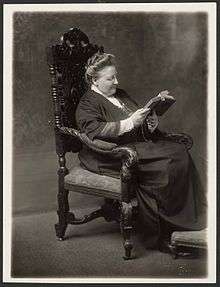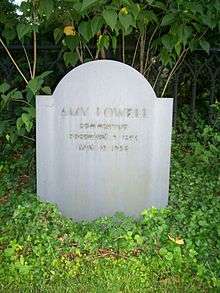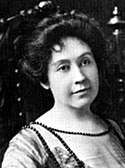Amy Lowell
Amy Lawrence Lowell (February 9, 1874 – May 12, 1925) was an American poet of the imagist school from Brookline, Massachusetts. She posthumously won the Pulitzer Prize for Poetry in 1926.
Amy Lawrence Lowell | |
|---|---|
_-_Bachrach.jpg) Lowell at Sevenels, circa 1916 | |
| Born | Amy Lawrence Lowell February 9, 1874 Brookline, Massachusetts, US |
| Died | May 12, 1925 (aged 51) Brookline, Massachusetts, US |
| Occupation | Poet |
| Notable awards | Pulitzer Prize for Poetry |
| Partner | Ada Dwyer Russell (together 1912–1925)[1]:xl,xlii[2][3] |
Personal life
_-_Notman.jpg)
Amy Lowell was born on February 9, 1874, in Boston, Massachusetts, the daughter of Augustus Lowell and Katherine Bigelow Lowell. A member of the Brahmin Lowell family, her siblings included the astronomer Percival Lowell, the educator and legal scholar Abbott Lawrence Lowell, and Elizabeth Lowell Putnam, an early activist for prenatal care. They were the great-grandchildren of John Lowell and, on their mother's side, the grandchildren of Abbott Lawrence.[4][5]
School was a source of considerable despair for the young Amy Lowell. She considered herself to be developing "masculine" and "ugly" features and she was a social outcast. She had a reputation among her classmates for being outspoken and opinionated.[6]
Lowell never attended college because her family did not consider it proper for a woman to do so. She compensated for this lack with avid reading and near-obsessive book collecting. She lived as a socialite and travelled widely, turning to poetry in 1902 (age 28) after being inspired by a performance of Eleonora Duse in Europe.
Lowell was said to be lesbian, and in 1912 she and actress Ada Dwyer Russell were reputed to be lovers. Russell is reputed to be the subject of Lowell's more erotic works, most notably the love poems contained in 'Two Speak Together', a subsection of Pictures of the Floating World. The two women traveled to England together, where Lowell met Ezra Pound, who at once became a major influence and a major critic of her work. Pound considered Lowell's embrace of Imagism to be a kind of hijacking of the movement. Lowell has been linked romantically to writer Mercedes de Acosta, but the only evidence of any contact between them is a brief correspondence about a planned memorial for Duse.
Lowell was a short but imposing figure who kept her hair in a bun and wore a pince-nez.

Lowell publicly smoked cigars, as newspapers of the day frequently mentioned.[7] A glandular problem kept her perpetually overweight. Poet Witter Bynner once said, in a comment frequently misattributed to Ezra Pound, that she was a "hippopoetess."[8] Her admirers defended her, however, even after her death. One rebuttal was written by Heywood Broun in his obituary tribute to Amy. He wrote, "She was upon the surface of things a Lowell, a New Englander and a spinster. But inside everything was molten like the core of the earth... Given one more gram of emotion, Amy Lowell would have burst into flame and been consumed to cinders."[9]

Lowell died of a cerebral hemorrhage in 1925, at the age of 51 and is buried at Mount Auburn Cemetery.[10] The following year, she was awarded the Pulitzer Prize for Poetry for What's O'Clock. That collection included the patriotic poem "Lilacs", which Louis Untermeyer said was the poem of hers he liked best.
Her first published work appeared in 1910 in Atlantic Monthly. The first published collection of her poetry, A Dome of Many-Coloured Glass, appeared two years later, in 1912. An additional group of uncollected poems was added to the volume The Complete Poetical Works of Amy Lowell, published in 1955 with an introduction by Louis Untermeyer, who considered himself her friend.
Though she sometimes wrote sonnets, Lowell was an early adherent to the "free verse" method of poetry and one of the major champions of this method. She defined it in her preface to "Sword Blades and Poppy Seed"; in the North American Review for January, 1917; in the closing chapter of "Tendencies in Modern American Poetry"; and also in the Dial (January 17, 1918), as: "The definition of Vers libre is: a verse-formal based upon cadence. To understand vers libre, one must abandon all desire to find in it the even rhythm of metrical feet. One must allow the lines to flow as they will when read aloud by an intelligent reader. Or, to put it another way, unrhymed cadence is "built upon 'organic rhythm,' or the rhythm of the speaking voice with its necessity for breathing, rather than upon a strict metrical system. Free verse within its own law of cadence has no absolute rules; it would not be 'free' if it had."[11]
Untermeyer writes that "[s]he was not only a disturber but an awakener."[12] In many poems, Lowell dispenses with line breaks, so that the work looks like prose on the page. This technique she labeled "polyphonic prose".[13]
Throughout her working life, Lowell was a promoter of both contemporary and historical poets. Her book Fir-Flower Poets was a poetical re-working of literal translations of the works of ancient Chinese poets, notably Li Tai-po (A.D. 701-762). Her writing also included critical works on French literature. At the time of her death, she was attempting to complete her two-volume biography of John Keats (work on which had long been frustrated by the noncooperation of F. Holland Day, whose private collection of Keatsiana included Fanny Brawne's letters to Frances Keats). Lowell wrote of Keats: "the stigma of oddness is the price a myopic world always exacts of genius."[14]
Lowell not only published her own work, but also that of other writers. According to Untermeyer, she "captured" the Imagist movement from Ezra Pound. Pound threatened to sue her for bringing out her three-volume series Some Imagist Poets, and thereafter derisively called the American Imagists the "Amygist" movement. Pound criticized her as not an imagist, but merely a rich woman who was able to financially assist the publication of imagist poetry. She said that Imagism was weak before she took it up, whereas others said it became weak after Pound's "exile" towards Vorticism.
Amy Lowell wrote at least two poems about libraries—The "Boston Athenauem"[15] and "The Congressional Library"[16]—during her career. A discussion of libraries also appears in her essay "Poetry, Imagination, and Education".[17]
Lesbian love poetry

Lowell's partner Ada Dwyer Russell was the subject of many of Lowell's romantic poems,[18] and Lowell wanted to dedicate her books to Dwyer who refused except for one time in a non-poetry book in which Lowell wrote, "To A.D.R., This, and all my books. A.L."[19] Examples of these love poems to Dwyer include the Taxi, Absence,[20]:xxi In a Garden, Madonna of the Evening Flowers,[21] Opal,[22] and Aubade.[23] Amy admitted to John Livingston Lowes that Dwyer was the subject of her series of romantic poems titled "Two Speak Together".[24][25] Lowell's poems about Dwyer have been called the most explicit and elegant lesbian love poetry during the time between the ancient Sappho and poets of the 1970s.[23] Most of the private correspondence in the form of romantic letters between the two were destroyed by Ada at Amy's request, leaving much unknown about the details of their life together.[20]:47
Legacy
In the post-World War I years, Lowell was largely forgotten, but the women's movement in the 1970s and women's studies brought her back to light. According to Heywood Broun, however, Lowell personally argued against feminism.[26]
Additional sources of interest in Lowell today come from the anti-war sentiment of the oft-taught poem "Patterns"; her personification of inanimate objects, as in "The Green Bowl", and "The Red Lacquer Music Stand"; and her lesbian themes, including the love poems addressed to Ada Dwyer Russell in "Two Speak Together" and her poem "The Sisters", which addresses her female poetic predecessors.
Lowell's correspondence with her friend Florence Ayscough, a writer and translator of Chinese literature, was compiled and published by Ayscough's husband Professor Harley Farnsworth MacNair in 1945.[27]
Works
- "Fireworks". The Atlantic Monthly. 115. April 1915.
Books
| Library resources about Amy Lowell |
| By Amy Lowell |
|---|
- A Dome of Many-Coloured Glass. Houghton Mifflin company. 1912.
Amy Lowell.
- Sword Blades and Poppy Seed. The Macmillan Company. 1914.
Amy Lowell sword blades.
- Men, Women and Ghosts. The Macmillan company. 1916.
Amy Lowell.
- Can Grande's Castle. The Macmillan Company. 1919. ISBN 0-403-00658-9.
- Pictures of the Floating World. The Macmillan company. 1919. ISBN 0-404-17128-1.
Amy Lowell.
- Legends. Houghton Mifflin company. 1921.
Amy Lowell.
- Fir-Flower Tablets. Houghton Mifflin Company. 1921. ISBN 0-88355-058-X.
Amy Lowell fir.
- A Critical Fable. READ BOOKS. 2007-10-26. ISBN 978-1-4086-0147-1.
- What's O'Clock. Houghton Mifflin Company. 1925.
- East Wind. Houghton Mifflin company. 1926.
Amy Lowell.
- Ballads for Sale. Houghton Mifflin company. 1927.
- The Complete Poetical Works of Amy Lowell. Houghton. 1955.
- ''Selected Poems of Amy Lowell'', ed. Melissa Bradshaw and Adrienne Munich, New Brunswick, NJ: Rutgers University Press, 2002.
- Naoki Ohnishi (ed.). Amy Lowell: Complete Poetical Works and Selected Writings in 6 vols. Kyo to: Eureka Press. ISBN 978-4-902454-29-1.
- The Complete Poetical Works of Amy Lowell with an introduction by Louis Untermeyer. Boston, Massachusetts: The Houghton Mifflin Company. (The Riverside Press, Cambridge), 1955.
- S. Foster Damon (1935). Amy Lowell: A Chronicle, With Extracts from her Correspondence. Boston: Houghton Mifflin Company.
- The Touch of You Amy Lowell's Poems of Love and Beauty selected by Peter Seymour. U.S.: Hallmark Cards, Inc. 1972. ISBN 0875292887.
- Men, Women And Ghosts. Kessinger Publishing, LLC. 2010. ISBN 1162673753.
Criticism
- AMY LOWELL (1925). JOHN KEATS. HOUGHTON MIFFLIN COMPANY.
Anthology
- Some imagist poets. 3. Houghton Mifflin Company. 1917. ISBN 1-4191-4804-4.
See also
- Amy Lowell Poetry Travelling Scholarship
Notes
- Munich, Adrienne; Bradshaw, Melissa (30 November 2002). Selected Poems of Amy Lowell. New Brunswick, NJ: Rutgers University Press. ISBN 0813531284.
- History Project (Boston, Mass.) (1998), Improper Bostonians: Lesbian and Gay History from the Puritans to Playland, Beacon Press, p. 75, ISBN 978-0-8070-7949-2
- Parker, Sarah (21 July 2015). The Lesbian Muse and Poetic Identity, 1889–1930. Routledge. p. 157. ISBN 978-1848933866.
- Lowell, Delmar R., The Historic Genealogy of the Lowells of America from 1639 to 1899 (Rutland VT: The Tuttle Company, 1899), 283
- "Chosön, the Land of the Morning Calm; a Sketch of Korea". World Digital Library. Retrieved 30 April 2013.
- Horace Gregory, Amy Lowell: Portrait of the Poet in her Own Time, Books for Libraries Press, Freeport, New York, 1958
- Gregory, pg.96
- Adrienne Munich; Melissa Bradshaw (2004). Amy Lowell, American modern. Rutgers University Press. p. 171. ISBN 978-0-8135-3356-8.
- "Amy Lowell 1874-1925". Isle of Lesbos. Alix North.
- Wilson, Scott. Resting Places: The Burial Sites of More Than 14,000 Famous Persons, 3d ed.: 2 (Kindle Location 28784). McFarland & Company, Inc., Publishers. Kindle Edition
- Lowes, Livingston John Conventions and Revolt in Poetry, 1919
- Alan Shucard; Fred Moramarco; William Sullivan (1990). Modern American poetry, 1865-1950. University of Massachusetts Press. p. 77. ISBN 978-0-87023-720-1.
- Michel Delville (1998). The American prose poem. University Press of Florida. p. 6. ISBN 978-0-8130-1591-0.
lowell polyphonic prose.
- Amy Lowell (1925). John Keats. II. Houghton Mifflin Company. p. 152.
- Lowell, Amy (1912). A Dome of Many-Coloured Glass. Boston: Houghton Mifflin Company. p. 115.
- Lowell, Amy. "The Congressional Library".
- Lowell, Amy. "Poetry, Education, and Imagination". Critical Essays by Amy Lowell. Modern American Poetry, University of Illinois. Retrieved 1 December 2016.
- Castle, Terry (13 December 2005). The Literature of Lesbianism: A Historical Anthology from Ariosto to Stonewall. Columbia University Press. p. 649. ISBN 0231125119.
- Bradshaw, Melissa; Munich, Adrienne (9 February 2004). Amy Lowell, American Modern. New Brunswick, NJ: Rutgers University Press. p. 62. ISBN 0813533562.
- Rollyson, Carl (8 August 2013). Amy Lowell Anew: A Biography. Rowman & Littlefield Publishers. ISBN 1442223928. Preface reprinted at the author's website.
- Hamer, Diane (30 December 2013). "The Love Songs of Amy Lowell". The Gay & Lesbian Review Worldwide. 21 (1): 48.
- Faderman, Lillian. "About Amy Lowell's Poetry". english.illinois.edu. University of Illinois.
- Karami, Siham (July–August 2016). "In the Manner of Amy Lowell" (PDF). The Gay & Lesbian Review Worldwide. 23 (4): 39.
- Faderman, Lillian. "Amy Lowell (1874-1925)". Georgetown University.
- Hamer, Diane Ellen (1 July 2004). "Amy Lowell wasn't writing about flowers". The Gay & Lesbian Review Worldwide. 11 (4). Reprinted at thefreelibrary.com.
- Sonja Samberger (2005). Artistic outlaws. Berlin-Hamburg-Münster: LIT Verlag. pp. 43–44. ISBN 978-3-8258-8616-5.
- Hillbrook, R (1946). "Florence ayscough and amy lowell". Current History (Pre-1986). 10: 445.
References
- Amy Lowell, American Modern: Critical Essays, ed. Adrienne Munich and Melissa Bradshaw, New Brunswick, NJ:Rutgers University Press, 2004.
- "Outselling the Modernisms of Men: Amy Lowell and the Art of Self-Commodification," Victorian Poetry Volume 38, No. 1 (Spring 2000), 141–169.
- Rollyson, Carl, Amy Lowell Anew: A Biography, Rowman & Littlefield Publisher, 2013. ISBN 978-1442223929.
External links
| Wikisource has original works written by or about: Amy Lowell |
| Wikiquote has quotations related to: Amy Lowell |
| Wikimedia Commons has media related to Amy Lowell. |
- Works by Amy Lowell at Project Gutenberg
- Works by or about Amy Lowell at Internet Archive
- Works by Amy Lowell at LibriVox (public domain audiobooks)

- Poems by Amy Lowell and biography at Poetry Foundation
- March 26, 1916, New York Times, How Does the New Poetry Differ from the Old?; Amy Lowell Laments the Lack of Authoritative Criticism in America -- Says No One Should Make a Living by Writing
| Awards and achievements | ||
|---|---|---|
| Preceded by Owen D. Young |
Cover of Time magazine March 2, 1925 |
Succeeded by Nicholas Longworth |